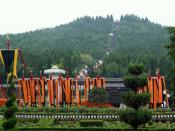No one can tell precisely when the building of the Great Wall was started but it is popularly believed that it originated as a military fortification against intrusion by tribes on the borders during the earlier Zhou Dynasty. Late in the Spring and Autumn Period (770 BC - 476 BC), the ducal states extended the defence work and built "great" structures to prevent the attacks from other states. It was not until the Qin Dynasty that the separate walls, constructed by the states of Qin, Yan and Zhao kingdoms, were connected to form a defensive system on the northern border of the country by Emperor Qin Shi Huang (also called Qin Shi Huangdi by westerners or the First Emperor). After the emperor unified the country in 214 BC, he ordered the construction of the wall. It took about ten years to finish and the wall stretched from Linzhao (in the eastern part of today's Gansu Province) in the west to Liaodong (in today's Jilin Province) in the east.
The wall not only served as a defence in the north but also symbolized the power of the emperor.
From the Qin Dynasty onwards, Xiongnu, an ancient tribe that lived in North China, frequently harassed the northern border of the country. During the Han Dynasty, Emperor Wu (Han Wu Di), sent three expeditions to fight against the Xiongnu in 127 BC, 121 BC and 119 BC. The Xiongnu were driven into the far north of the Gobi. To maintain the safety of the Hexi Corridor (today's Gansu Province), the emperor ordered the extension of the Great Wall westward into the Hexi Corridor and Xinjiang region. The ruins of the beacon towers and debris of the Han Wall are still discernible in Dunhuang, Yumen and Yangguan. A recent report shows that ruins of...


